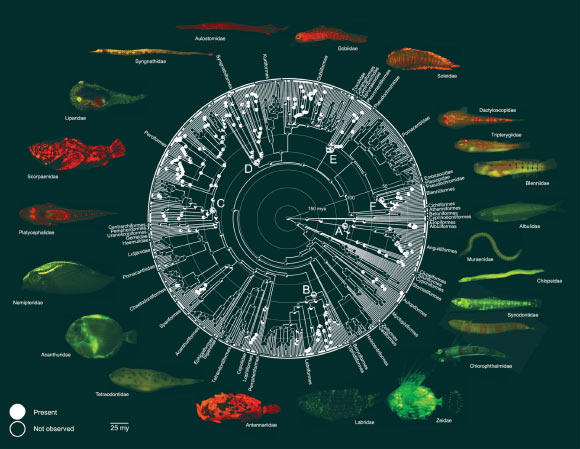Biofluorescence, the absorption of high-energy light and its reemission at lower energy wavelengths, is widespread across vertebrate and invertebrate lineages, especially fishes. According to two studies led by the American Museum of Natural History, fish biofluorescence dates back at least 112 million years and, since then, has evolved independently more than 100 times, with the majority of that activity happening among fish that live on coral reefs.
Phylogeny of teleost fishes showing ancestral state reconstructions of biofluorescence (absence/presence). Image credit: Carr et al., doi: 10.1038/s41467-025-59843-7.
“Researchers have known for a while that biofluorescence is quite widespread in marine animals, from sea turtles to corals, and especially among fishes,” said Emily Carr, a Ph.D. student at the American Museum of Natural History.
“But to really get to the root of why and how these species use this unique adaptation — whether for camouflage, predation, or reproduction — we need to understand the underlying evolutionary story as well as the scope of biofluorescence as it currently exists.”
In the first study, published in the journal Nature Communications, Carr and colleagues examined all known biofluorescent teleosts, a type of bony fish that make up by far the largest group of vertebrates alive today.
This resulted in a list of 459 biofluorescent species, including 48 species that were previously unknown to be biofluorescent.
The researchers found that biofluorescence evolved more than 100 times in marine teleosts and is estimated to date back about 112 million years, with the first instance occurring in eels.
They also found that fish species that live in or around coral reefs evolve biofluorescence at about 10 times the rate of non-reef species, with an increase in the number of fluorescent species following the end-Cretaceous extinction about 66 million years ago, when all of the non-avian dinosaurs died off.
“This trend coincides with the rise of modern coral-dominated reefs and the rapid colonization of reefs by fishes, which occurred following a significant loss of coral diversity in the end-Cretaceous extinction,” Carr said.
“These correlations suggest that the emergence of modern coral reefs could have facilitated the diversification of fluorescence in reef-associated teleost fishes.”
Of the 459 known biofluorescent teleosts reported in the study, the majority are associated with coral reefs.
For the second study, published in the journal PLoS ONE, Carr and co-authors used a specialized photography setup with ultraviolet and blue excitation lights and emission filters to look at the wavelengths of light emitted by fishes in the Ichthyology collection of the American Museum of Natural History.
Collected over the last decade and a half on Museum expeditions to the Solomon Islands, Greenland, and Thailand, the specimens in the study were previously observed fluorescing, but the full range of their biofluorescent emissions was unknown.
The work reveals far more diversity in colors emitted by teleosts — some families of which exhibit at least six distinct fluorescent emission peaks, which correspond with wavelengths across multiple colors — than had previously been reported.
“The remarkable variation we observed across a wide array of these fluorescent fishes could mean that these animals use incredibly diverse and elaborate signaling systems based on species-specific fluorescent emission patterns,” said Dr. John Sparks, curator at the American Museum of Natural History.
“As these studies show, biofluorescence is both pervasive and incredibly phenotypically variable among marine fishes.”
“What we would really like to understand better is how fluorescence functions in these highly variable marine lineages, as well as its role in diversification.”
“The numerous wavelengths of fluorescent emissions found in this study could have implications for identifying novel fluorescent molecules, which are routinely used in biomedical applications, including fluorescence-guided disease diagnosis and therapy.”
_____
E.M. Carr et al. 2025. Repeated and widespread evolution of biofluorescence in marine fishes. Nat Commun 16, 4826; doi: 10.1038/s41467-025-59843-7
E.M. Carr et al. 2025. Marine fishes exhibit exceptional variation in biofluorescent emission spectra. PLoS One 20 (6): e0316789; doi: 10.1371/journal.pone.0316789

























